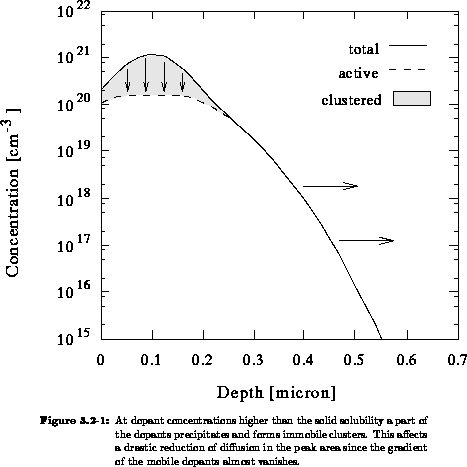3.2.2 High Concentration Effects (Models DIFSCL and DIFDCL)




Next: Dynamic Clustering (Model
Up: 3.2 Model Library
Previous: Model Parameters
During VLSI technology processes, mainly for shallow junction formation,
dopant concentrations higher than solid solubility and off equilibrium
conditions are generally employed. At high dopant concentrations not all
dopant atoms are ionized due to clustering and precipitation. The total
concentration of an impurity  will be made up by a mobile (active) part
will be made up by a mobile (active) part  and an immobile (clustered) part
and an immobile (clustered) part  ,
(
,
( ). This cluster formation causes a drastic
reduction of the diffusion coefficient at high concentrations because the
gradient of the active atoms almost vanishes and the clustered part of the
dopants does not diffuse (see Figure 3.2-1).
). This cluster formation causes a drastic
reduction of the diffusion coefficient at high concentrations because the
gradient of the active atoms almost vanishes and the clustered part of the
dopants does not diffuse (see Figure 3.2-1).

For boron and antimony the inactive dopants form relatively large
precipitates, whereas the inactive arsenic and phosphorus atoms form very
small coherent precipitates or clusters [Sol90]. An impurity cluster
 is composed of
is composed of  impurity atoms and
impurity atoms and  electrons. The cluster
formation process (3.2-10) does not occur instantaneously,
several hours at
electrons. The cluster
formation process (3.2-10) does not occur instantaneously,
several hours at  and a few minutes at
and a few minutes at  are necessary to
attain equilibrium conditions [Sol90].
are necessary to
attain equilibrium conditions [Sol90].

Commonly used process simulations are inadequate to correctly predict the
dopant redistribution in supersaturated conditions.
SUPREM III [Ho83b] and PREDICT [Fai88], even
though assuming a maximum electrically active solubility, consider all
dopants mobile during thermal treatment. On the contrary, ICECREM
[Pic90] hypothesizes the instantaneous aggregation of dopant atoms to
form immobile clusters.
In PROMIS' model library we supply two models for clustering
effects, a kinetic (dynamic) clustering model DIFDCL and an
equilibrium (static) clustering model DIFSCL.
Martin Stiftinger
Wed Oct 19 13:03:34 MET 1994
 will be made up by a mobile (active) part
will be made up by a mobile (active) part  and an immobile (clustered) part
and an immobile (clustered) part  ,
(
,
( ). This cluster formation causes a drastic
reduction of the diffusion coefficient at high concentrations because the
gradient of the active atoms almost vanishes and the clustered part of the
dopants does not diffuse (see Figure 3.2-1).
). This cluster formation causes a drastic
reduction of the diffusion coefficient at high concentrations because the
gradient of the active atoms almost vanishes and the clustered part of the
dopants does not diffuse (see Figure 3.2-1).





 is composed of
is composed of  impurity atoms and
impurity atoms and  electrons. The cluster
formation process (
electrons. The cluster
formation process ( and a few minutes at
and a few minutes at  are necessary to
attain equilibrium conditions
are necessary to
attain equilibrium conditions 